Let’s Take a Trip to an American Village 2: Downtown
July 19, 2009
Last week, we took a trip to an American village: New Berlin, NY 13411. This village of about 1000 people hasn’t seen much development since 1915 or so, leaving it in close to its original 19th century state. (Actually, it was a much more lively place then.)
July 12, 2009: Let’s Take a Trip to an American Village
This is part of our series on villages:
March 3, 2009: Let’s Visit Some More Villages
February 15, 2009: Let’s Take a Trip to the French Village
February 1, 2009: Let’s Take a Trip to the English Village
This sort of thing is rare these days, but it occupies a major portion of the American imagination. I called this the “Yankee Heartland,” because it is an example of what Americans think of as good, right and proper — their ethnic heritage, and also the template for their material aspirations. This applies even if you happen to be the child of a Lebanese immigrant and his Laotian wife, because even if that is the case, I don’t think your “dream house” is going to be a bamboo fishing cottage on stilts. I suppose a Mongolian probably thinks there is no better mode of living than to reside in a tent on the steppes of North Asia. So, there is a certain arbitraryness to it.
Thus, it is perfectly natural to imagine, for an American, that the best mode of living is a small town in a rural setting, with the “right sort” of people with upstanding Yankee values and European descent. Of course, nobody actually wants to live in a small town in a rural setting (which is why New Berlin has been declining in population for a hundred years), because there are no jobs, but, having acquired a job in a big city, that is the format that they aspire to if they have the means. I can attest that indeed there is a strong core of colonial Yankee moral fiber and community in a place like this, of the sort that is hinted at in Norman Rockwell paintings.
However, the problem is that the Small Town America format is not suited for an urbanization of more than about 5000 people. As we will see, it is not even very well suited for populations of less than that, but at least its inherent flaws and contradictions are less apparent at the smaller size. The bigger you get with this mode of City Design, the bigger the problems become — which is the opposite of the Traditional City mode of design. In the Traditional City, the bigger you get, the better things get.
Let’s continue our walk down Main Street.
After the school, we come to the edge of the “downtown” commercial area. We see that the format of the City Design changes here, from one of freestanding houses (or churches or schools) surrounded by grass, to one of multistory buildings side-by-side and right up against the sidewalk.
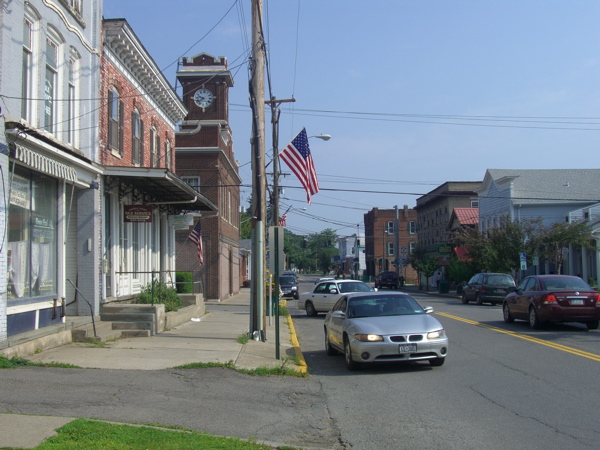
Once again, I note that the width of the road here is rather exceptionally wide, by Traditional City standards. It “makes sense” considering today’s auto traffic, but what were they thinking in 1800 or so when this street was laid out? It is vastly larger than is needed for pedestrians or even the occasional wagon.
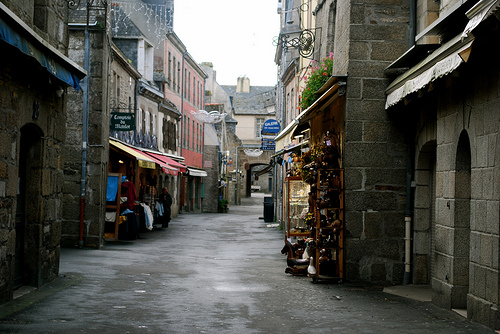
This is a similar commercial street, in a French village.
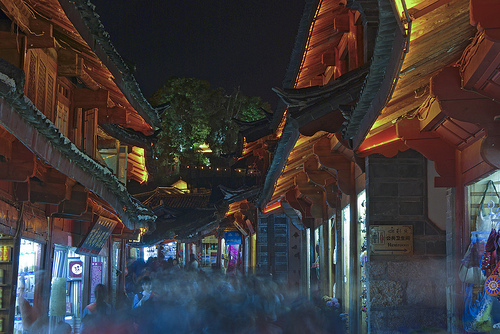
A commercial street in a Chinese village.
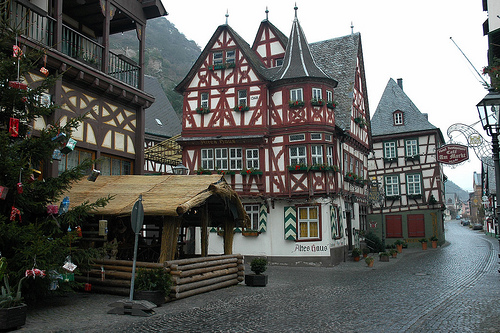
A commercial street in a German village.
Beginning with the Industrial Revolution around 1775, a new aesthetic gripped the Western world. I call this 19th Century Hypertrophism. We can see that the 19th century example has a vastly larger roadway than the European examples which likely date from before 1800. Why? This was long before automobiles of course. In the later 19th century, there was probably more wagon traffic, but in 1800 I wouldn’t expect there to be considerably more wagon traffic than in earlier decades. The width of the American village Main Street is rather absurd for the pedestrian and the occasional horse or wagon, which is all there was in those days, and all there had ever been for the last 4000 years.
At the risk of recycling too much old material, I would again recommend here Episode 13 of Kenneth Clarke’s classic BBC television series Civilisation, which puts the 19th century into context of the entirety of European civilization.
Civilisation Episode 13: Heroic Materialism
Clarke points out that, beginning with the new technologies and industrial processes of the Industrial Revolution, people’s aesthetic sense turned to civil engineering as a means of expression, rather than cathedrals or other architecture. People expressed their creativity, ability and wealth with things like bridges, highways and dams. Mass production, as opposed to the personal one-off production of the local cobbler, tailor, potter or blacksmith, was the new theme of the Industrial Revolution. Mass production was never about quality, of course. It was about volume and price. It expressed itself in repetitious homogenaity. And bigness, of course. Bigger was Better. More was Better. People were fascinated with their newfound powers of creation, their ability to manipulate material and natural resources on an unprecedented scale. Why make a road only 15 feet wide? How about 30 feet? 100 feet? 300 feet? Woo Hoo! The idea of handmade quality, that Better was Better, became a quaint notion of an intellectual subclass of the elites. Thus, we go from the architecture of the rather astonishing building above, in the German village, which expresses craftsmanship, ornamentation, artistic vision, cultural sophistication, and one-of-a-kind originality, to an architecture of very utilitarian buildings and machine-like repetition:
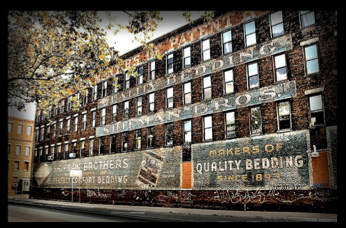
Factory building, Newark, NJ
At first, people limited this sort of repetitious, simplistic architecture to utilitarian purposes like a factory. For their “fun” things, like a hotel or personal residence, they went all-out:
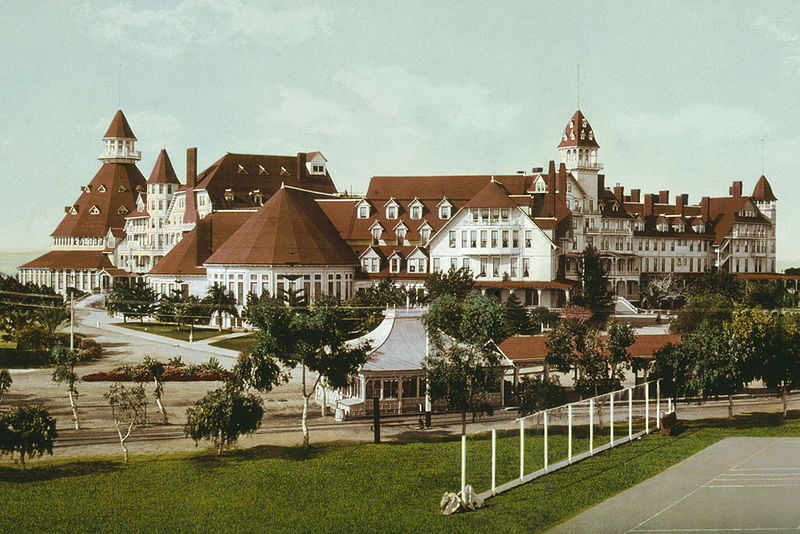
Hotel Del Coronado, San Diego. (Opened 1888.)
However, in time, this mass-production factory ideal has spread to encompass virtually all aspects of architecture and City Design.
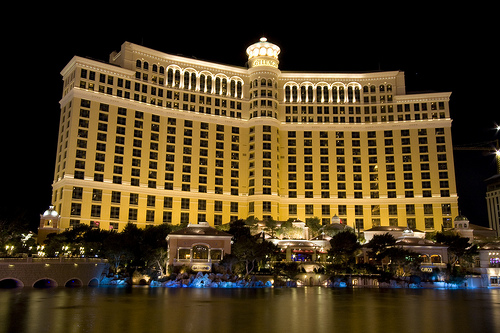
Bellagio Hotel, Las Vegas.
So, I would suggest that the emergence of 19th Century Hypertrophism was really a sort of aesthetic theme, rather than a rational response to some utilitarian need. The Traditional City was abandoned, probably without much consicous thought, to a new ideal of Bigness. And, this is apparent in a small Yankee town laid out around 1800. When automobiles came, around 1920 let’s say, the urban environment had already been designed for automobiles for 120 years. And, by making everything big, and easy to drive in, they had consequently created the desire and need for automobiles, because a city that is Big Big Big is inherently hard to walk around in. Even if it is not impossible to walk around in, there is simply this big open expanse of space in the middle which was practially begging for a purpose. And what better expression of the aesthetic of factory industrialization and mechanical self-empowerment than the automobile? It was a continuation of the 19th century Hypertrophic Ideal.
We haven’t even gotten to the stoplight yet. Keep on walking.
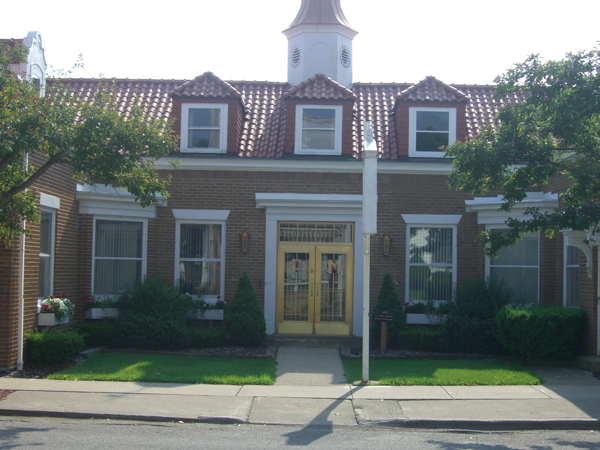
The front of the Preferred Mutual building, an insurance company and the town’s largest employer.
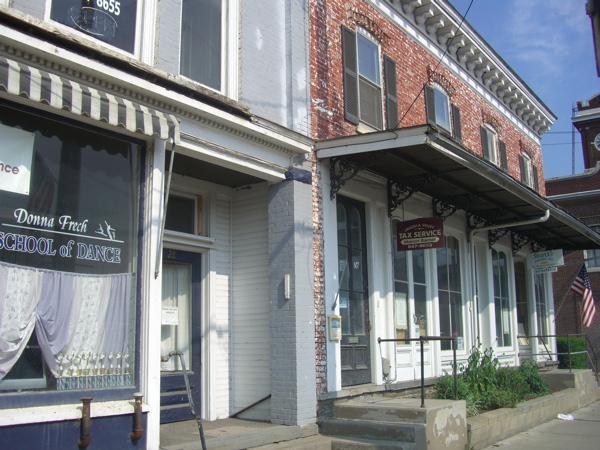
Typical commerical storefronts, with apartments/offices on the upper floors. Right up against the street, the way it’s supposed to be, and side-by-side with no space in between. Nice. Nothing wrong with this. These buildings are a Traditional City element, and work fine, although it seems there is a vestigal desire for a setback and “green space” in the form of a two-foot-wide shrubbery. Is that really necessary?
Lots of “New Urbanist” types focus on this sort of architecture, as they should, because it is very successful and an important part of any city designed for people (“pedestrians”) instead of cars. However, in the 19th century Hypertrophic City, or Hypertrophic Small Town as the case may be, this Traditional City sort of building was wedded with exceedingly wide streets, and the overall result is unsuccessful. That’s why I say that you must put the Really Narrow Streets first, because without that element, you can have some perfectly decent buildings like this but you will still fail.
It is easy to take a nice picture in New Berlin IF you don’t have the roadway in the picture.
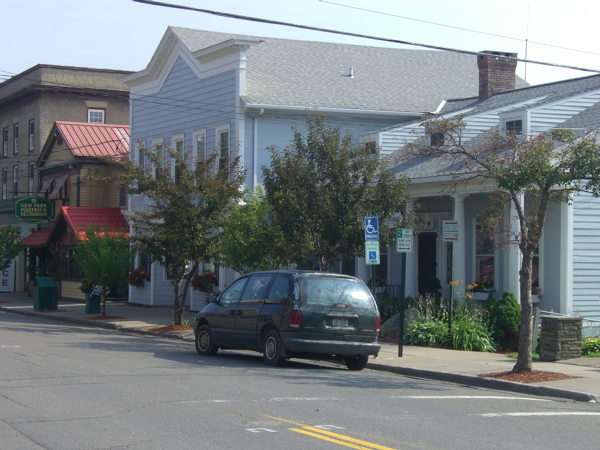
More storefronts.
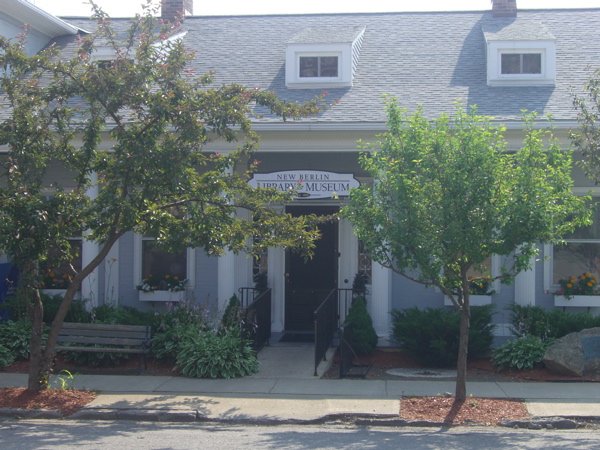
The library and museum. A nice place.
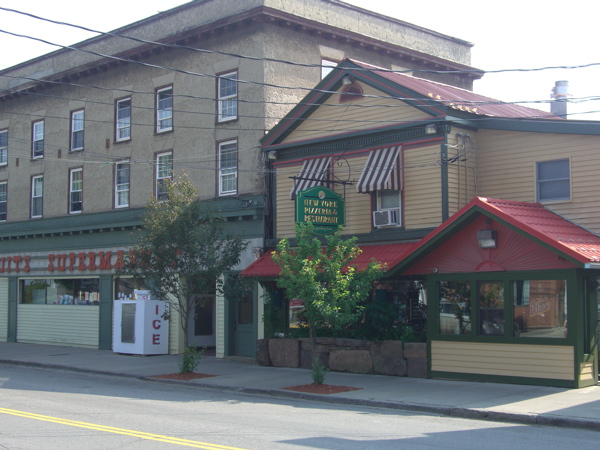
A supermarket and a pizza restaurant. Every town in this area has a pizza restaurant, but this one is especially good. The proprietor immigrated from Italy in the 1970s. Note that the supermarket has no parking. Cool!
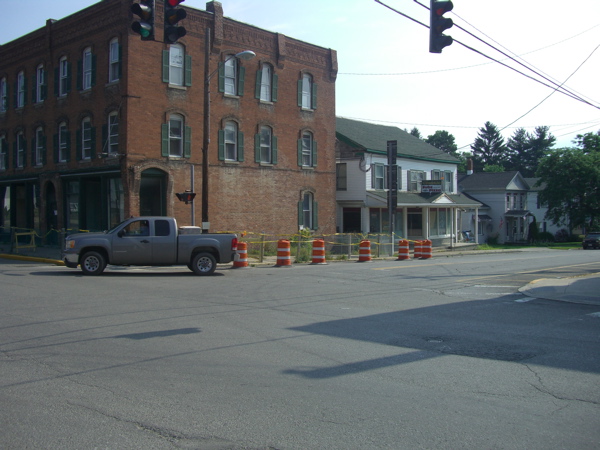
One corner of the main intersection. Rather a large expanse of blacktop …
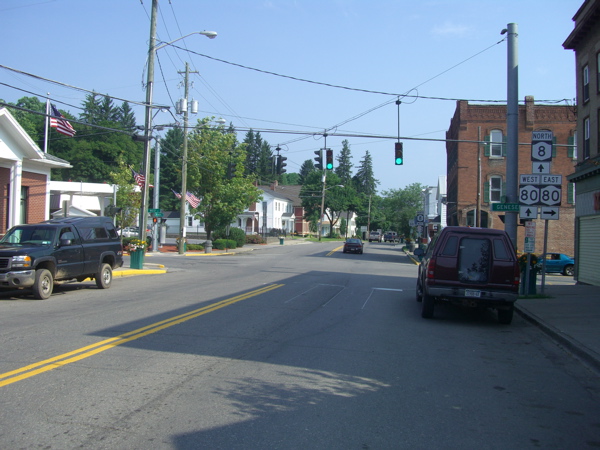
Another view of the intersection, just to give an idea of the scale. How many feet is that building to building? I would say about sixty.
On the far left corner, there’s a gas station today. In the past, there was a rather spectacular hotel called the Eagle.
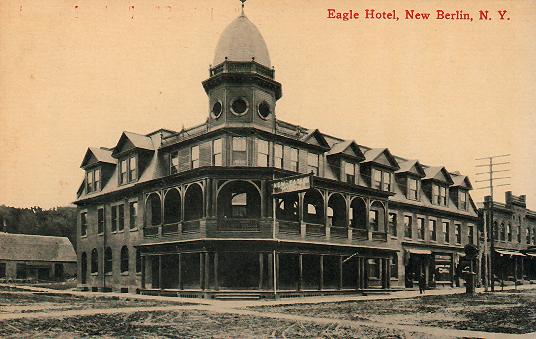
It ain’t no Motel 6, that’s for sure! People made beautiful things in those days. But, they still had an unpaved road in the middle. As I mentioned last week, one consequence of making such enormous roadways is that they were very difficult to pave until the advent of asphalt. So, the New Berliners walked around in the mud for about 120 years. Oops.
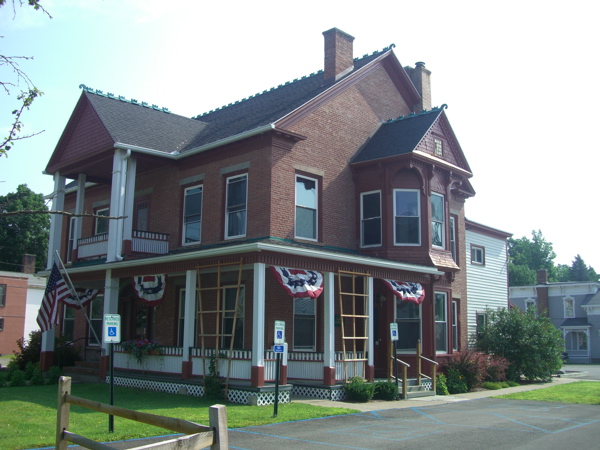
The Town Hall, a little north of the intersection. Shows some civic pride! Look at the decorations along the roofline.
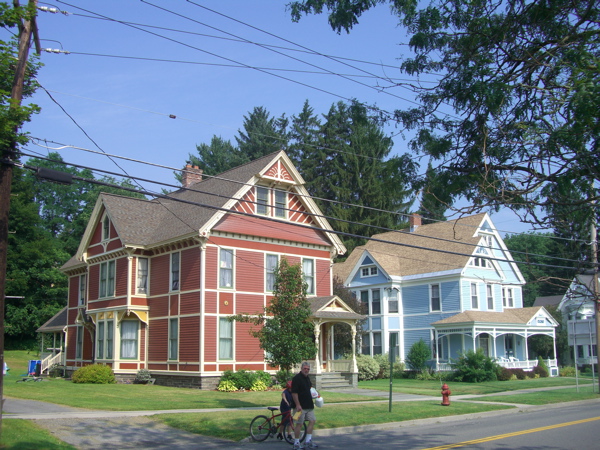
Back to the residential mode here, of detached farmhouses. This is just north of the intersection.
Rather too many people, including the New Urbanist types and also some “sustainability” types, fixate on this sort of 19th century rural village format as some sort of ideal to aspire to. And, there is a lot that is quite wonderful, especially the beautiful buildings, and what hints of the Traditional City format exist. However, as I said last week, this is also largely identical to the postwar suburban format as well, and has all of the inherent problems of that format. You can’t fix the problems of Suburban Hell by making more suburbs! Once we see that this is not a Traditional City format, but actually 19th century Hypertrophism, the way forward becomes clearer.
People talk today about “walkability” and “urban density.” New Berlin is actually walkable. Often I don’t drive my car for many days at a stretch. But, it is hardly dense. Many modern suburbs are considerably denser. You can’t fix the problems of low density by adopting a model that has even lower density. Duh!
Let’s end today with some aerial photos that illustrate what I mean.
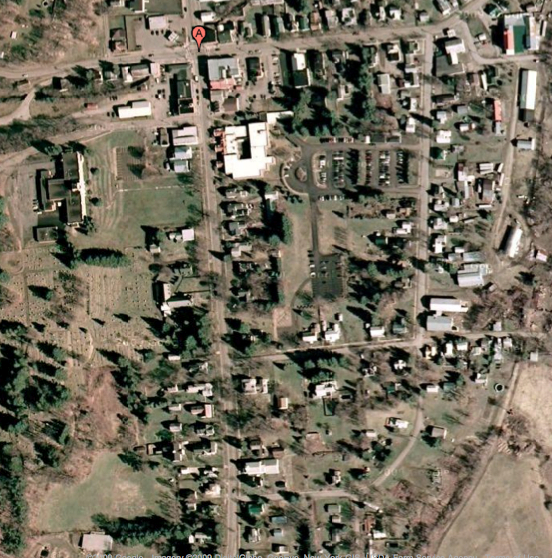
This is an aerial photo of Main Street, showing our little walking path. We started near the bottom of this photo, and ended near the A mark which is the central intersection. This is actually about half the town — the other half is north of the intersection. This photo is about 600-700 meters from side to side. All the photos following have approximately the same scale.
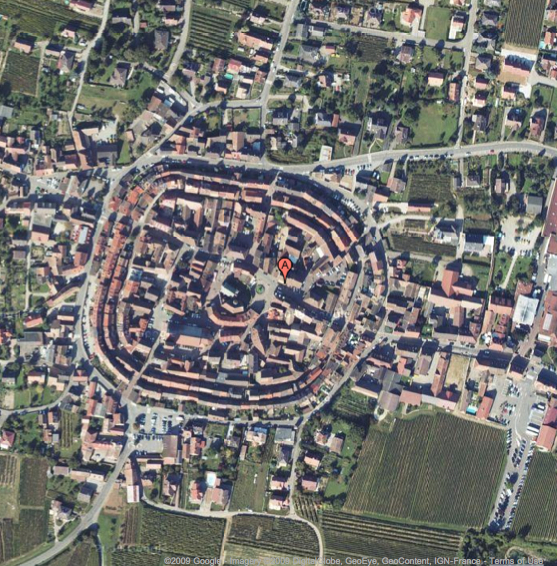
The village of Eguisheim, Alsace, France. Same scale.
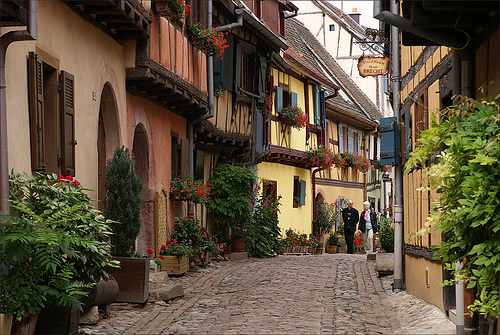
Street level view of Eguisheim.
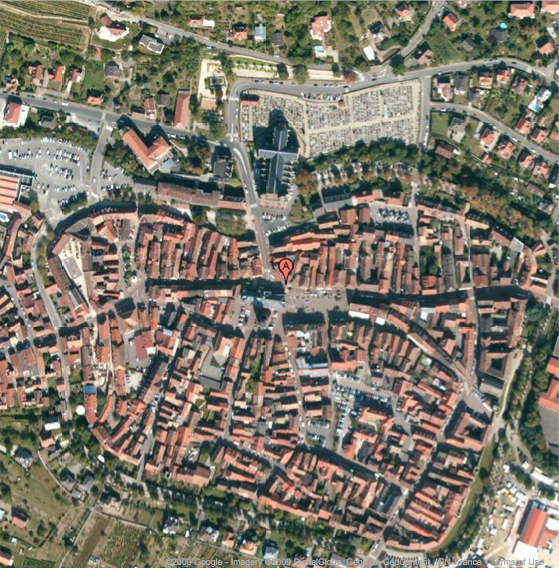
The village of Obernai, Alsace, France. Same scale.
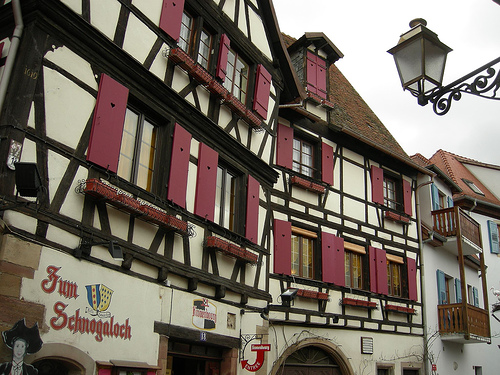
Obernai.
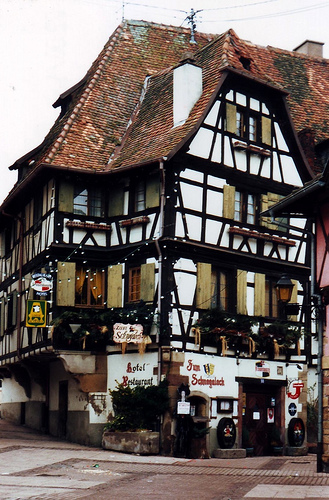
Obernai.
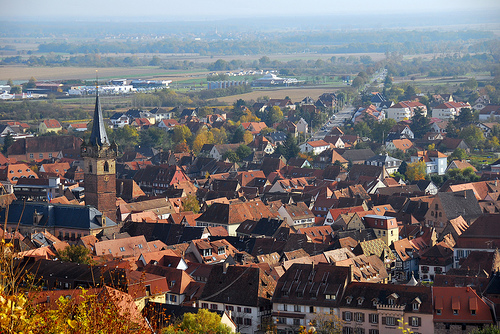
Obernai from above.
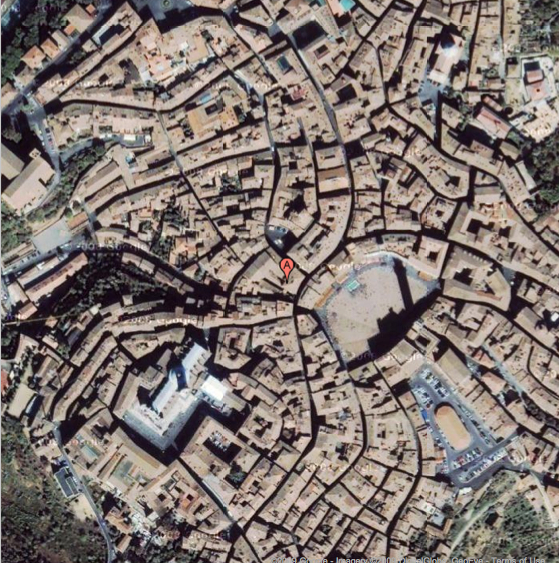
Siena, Italy. Note that narrowness of the streets. Same scale.
Of the tens of thousands of tourists that visit each year, I don’t think one has ever thought: “the streets here are too narrow.”
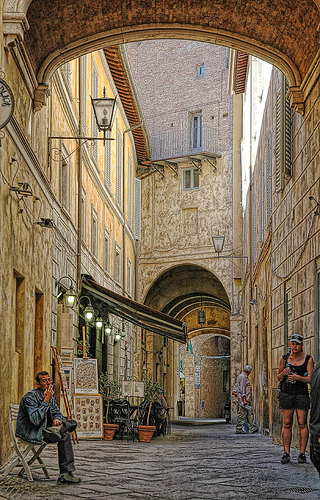
Street level view of Siena. (A photo with some computer artification apparently.)
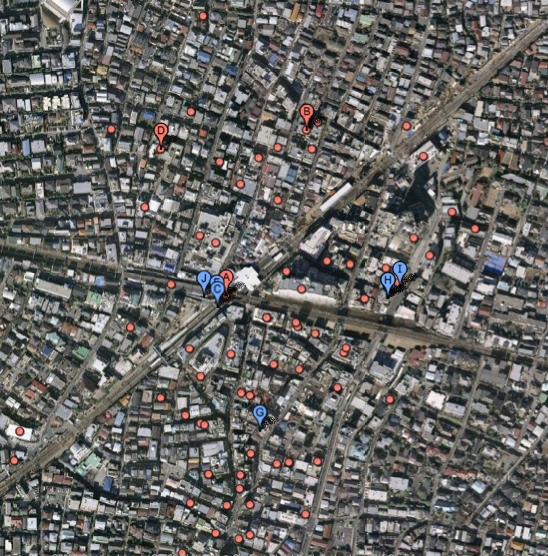
Shimo Kitazawa, a neighborhood in western Tokyo. Same scale. Very walkable and LOTS of fun. The central “intersection” is actually an intersection of train lines, with a big train station, not a roadway.
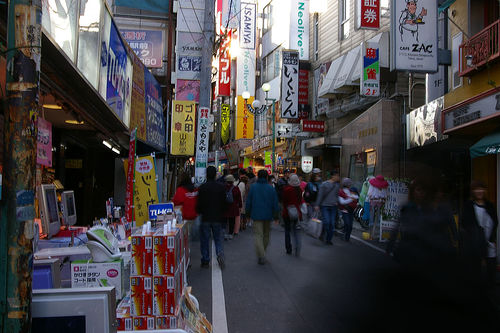
Street view of Shimo Kitazawa. Where are the CARS?
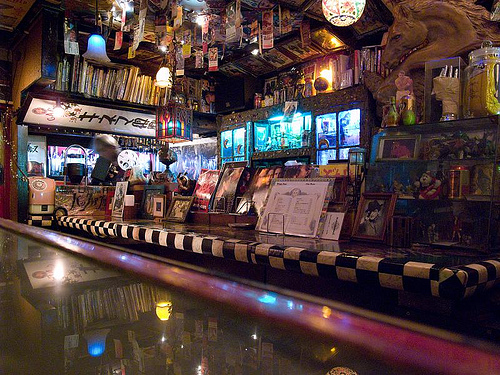
A place to drink in Shimo Kitazawa. The town has dozens — maybe hundreds — of cool bars like this.
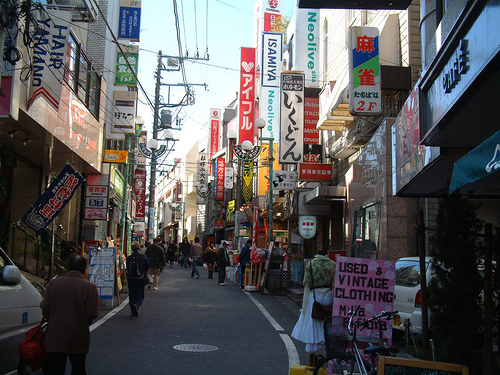
Shimo Kitazawa street.
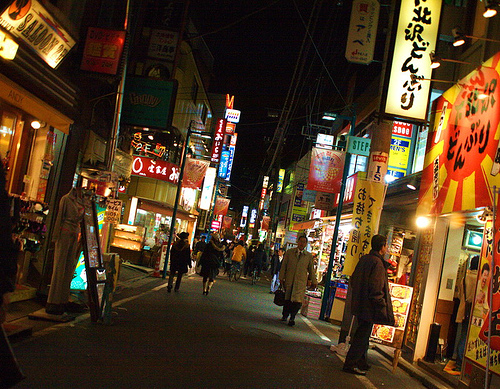
Not too many cars in Shimo Kitazawa.
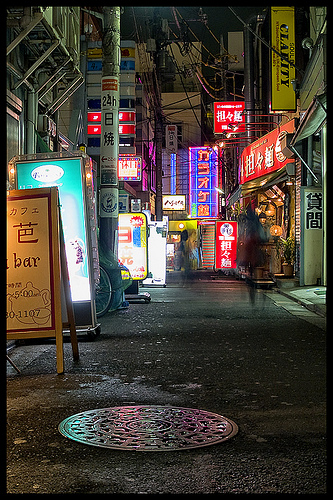
More places to eat, drink and be merry.
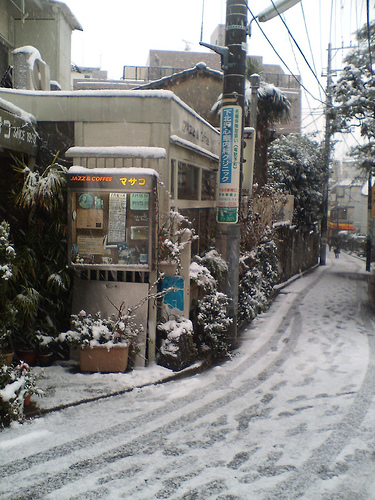
Masako, a famous jazz cafe in Shimo Kitazawa that I liked to go to. Isn’t the snow beautiful? Snow is fun when you aren’t driving.
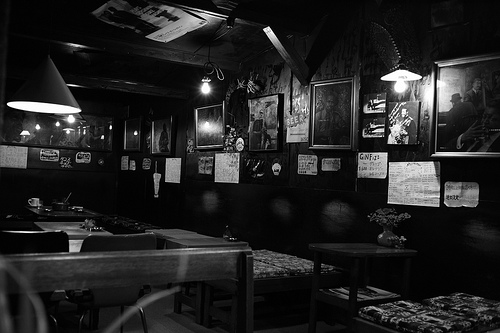
Inside Masako.
It ain’t Starbucks! They have an impressive collection of vinyl records, which they play with vintage tube amplifiers and huge JBL studio monitor speakers.
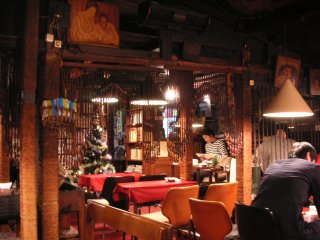
KONICA MINOLTA DIGITAL CAMERA
More photos of the inside of Masako. Just one cafe among the hundreds of places in the neighborhood.
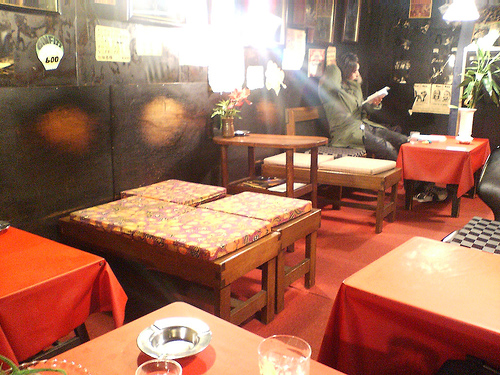
Ummm … what was I talking about again?
![]()
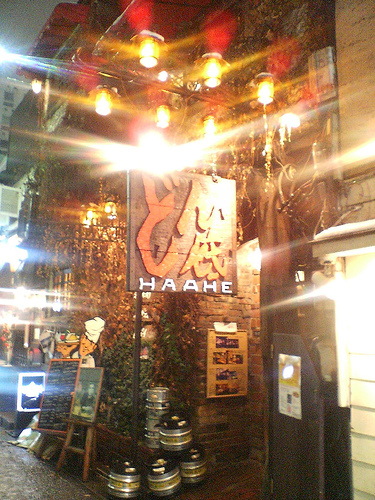
Entrance to a tavern in Shinjuku, a few train stations away from Shimo Kitazawa.
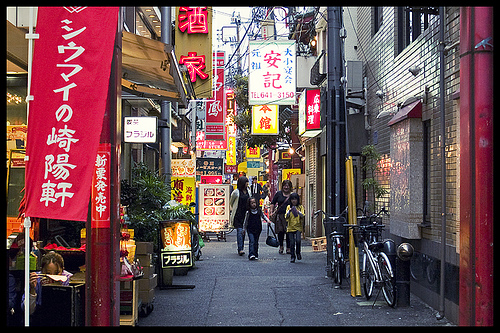
Apropos of nothing, Chinatown in Yokohama. Lots of fun there too. A friend of mine used to have a coffeehouse here with a 1920s theme. It was sweeet.
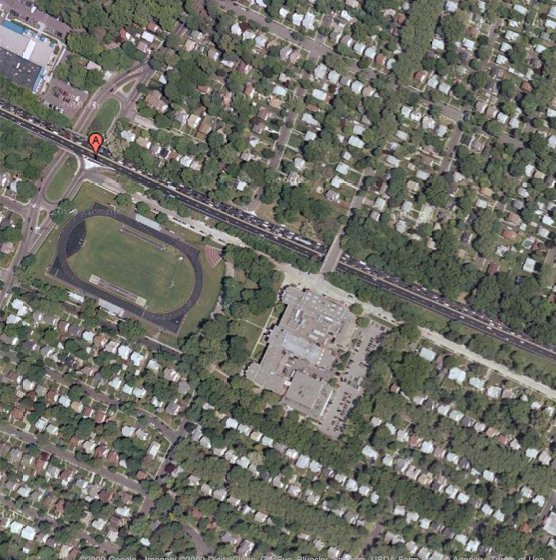
Teaneck, NJ, a typical postwar suburb. Rather hellish (yes, I’ve been there).
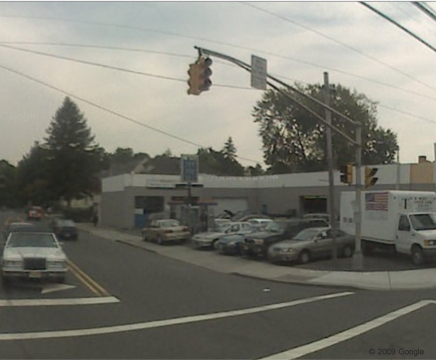
Street level view of Teaneck.
It’s pretty clear to me what works and what doesn’t. Have I driven a stake through your Small Town America fantasies yet? I see a lot of people on the Internet who act like they know something about “sustainable development” and “walkable cities,” or “carfree cities,” or “New Urbanism” or “Transportation Oriented Develoment.” (How about “People Oriented Development”?) Then, I look at their plans and I see something much more like 19th Century Hypertrophism, or maybe 20th Century Hypertrophism with trains. Listen: If you do this, you are going to fail. We’ve already had 100, or maybe 200 years of failure. Do we really need another 100 years of failure before we finally figure out that we already knew all the answers, in the form of the Traditional City?
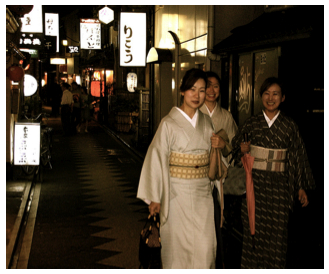
“Blah blah blah. Does this guy ever shut up? Actually, everything you need to know is in this one photo.”
* * *
On a related note, a reader at The Oil Drum offered these two photos, which describe the difference between the Hypertrophic City and the Traditional City. The top one is part of Seoul, South Korea, and the bottom one is Paris, France.
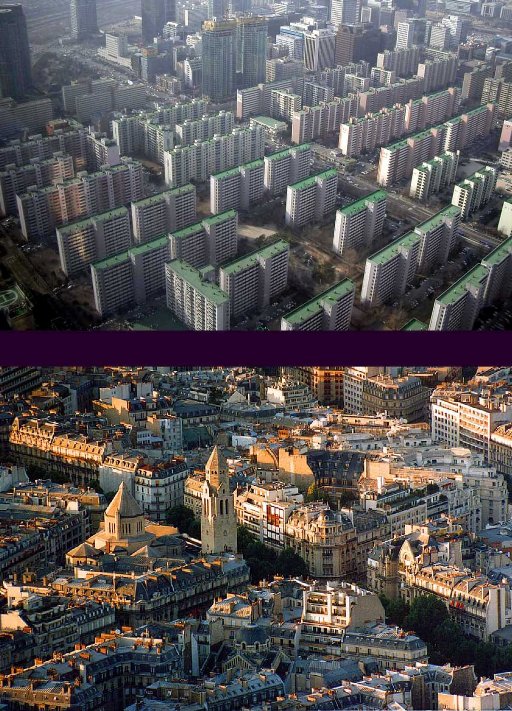
I mean, really. Look at that top picture. Can you imagine anything more idiotic? But people keep doing this over and over. No wonder people pine for the Small Towns of their historical fantasies. And look at the bottom picture. Can you improve on this? I can. I would make it more Shimo Kitazawa-y. Because I’ve been to both, and the Shimo Kitazawa model is really fun, in a way that I think no European city can match. But Paris is pretty much OK as is, so if your skills at City Design are still in a formative stage, you can imitate the Paris example and your grandchildren won’t hate you.
Other commentary in this series:
July 12, 2009: Let’s Take a Trip to an American Village
March 3, 2009: Let’s Visit Some More Villages
February 15, 2009: Let’s Take a Trip to the French Village
February 1, 2009: Let’s Take a Trip to the English Village
January 25, 2009: How to Buy Gold on the Comex (scroll down)
January 4, 2009: Currency Management for Little Countries (scroll down)
December 28, 2008: Currencies are Causes, not Effects (scroll down)
December 21, 2008: Life Without Cars
August 10, 2008: Visions of Future Cities
July 20, 2008: The Traditional City vs. the “Radiant City”
December 2, 2007: Let’s Take a Trip to Tokyo
October 7, 2007: Let’s Take a Trip to Venice
June 17, 2007: Recipe for Florence
July 9, 2007: No Growth Economics
March 26, 2006: The Eco-Metropolis
* * *
PIMCO Bond Guy Says: “Please devalue my sorry ass.”
McCulley Says Fed Needs To ‘Be Irresponsible’ If Prices Tumble
By Dakin Campbell
July 15 (Bloomberg) — Pacific Investment Management Co.’s Paul McCulley said the Federal Reserve should push inflation above its long-term target to coax consumers to spend money if the U.S. economy stays mired in recession.
“The way to make monetary policy effective is for the central bank to promise to be irresponsible,” McCulley wrote in a July commentary posted to Pimco’s Web site, citing a 1998 paper written by Princeton University economist Paul Krugman.
“Radically” different central-bank policy may be needed to change inflation expectations if the U.S. economy starts to resemble Japan’s era of deflation, McCulley wrote. He said the U.S. economy is not currently suffering from deflation. In addition to Krugman’s paper, McCulley cited a May 2003 speech by Fed Chairman Ben S. Bernanke as a blueprint for policy.
http://www.bloomberg.com/apps/news?pid=20601087&sid=akpxGSwUoMuA

